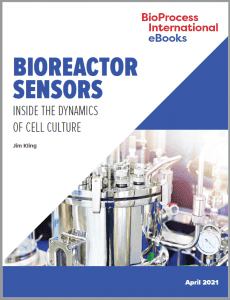eBook: Bioreactor Sensors — Inside the Dynamics of Cell CultureeBook: Bioreactor Sensors — Inside the Dynamics of Cell Culture
April 30, 2021
 Cell culture monitoring can fall into something like a “black box” conundrum. Efforts to measure key parameters such as pH, glucose, and even cell density require sampling and removal of the contents from a bioreactor. But that procedure can expose both a process and an operator to contamination risks. Emerging bioreactor sensors are designed to address some of those challenges, but the rapid adoption of single-use technologies and the rise of perfusion cell culture have presented obstacles to their implementation. In this eBook, science writer Jim Kling explores how next-generation sensors and extensions of existing product lines could help upstream scientists to learn more about their cell cultures without compromising product quality attributes. Read on to learn about improvements to sensors embedded in single-use bioreactor systems, novel designs for inline electrochemical sensing, and challenges that remain for developing sensors for continuous bioproduction. Kling’s discussion also considers how wireless and cloud-connected sensor technologies as well as statistical-model–based “soft sensors” could facilitate culture monitoring.
Cell culture monitoring can fall into something like a “black box” conundrum. Efforts to measure key parameters such as pH, glucose, and even cell density require sampling and removal of the contents from a bioreactor. But that procedure can expose both a process and an operator to contamination risks. Emerging bioreactor sensors are designed to address some of those challenges, but the rapid adoption of single-use technologies and the rise of perfusion cell culture have presented obstacles to their implementation. In this eBook, science writer Jim Kling explores how next-generation sensors and extensions of existing product lines could help upstream scientists to learn more about their cell cultures without compromising product quality attributes. Read on to learn about improvements to sensors embedded in single-use bioreactor systems, novel designs for inline electrochemical sensing, and challenges that remain for developing sensors for continuous bioproduction. Kling’s discussion also considers how wireless and cloud-connected sensor technologies as well as statistical-model–based “soft sensors” could facilitate culture monitoring.
Fill out the form below to read the eBook and learn about bioreactor sensors now.
You May Also Like





